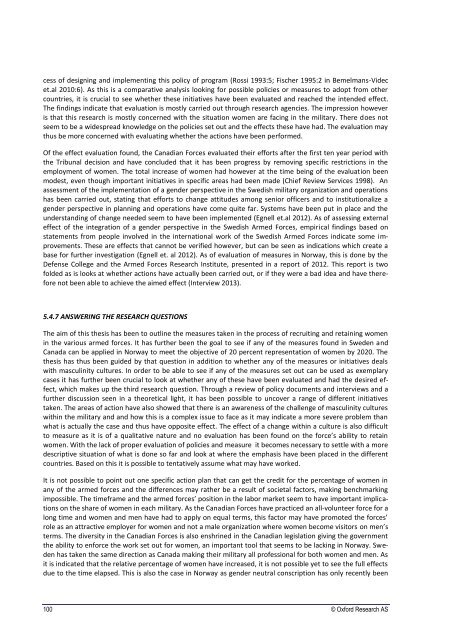You also want an ePaper? Increase the reach of your titles
YUMPU automatically turns print PDFs into web optimized ePapers that Google loves.
cess of designing and implementing this policy of program (Rossi 1993:5; Fischer 1995:2 in Bemelmans-Videc<br />
et.al 2010:6). As this is a comparative analysis looking for possible policies or measures to adopt from other<br />
countries, it is crucial to see whether these initiatives have been evaluated and reached the intended effect.<br />
The findings indicate that evaluation is mostly carried out through research agencies. The impression however<br />
is that this research is mostly concerned with the situation women are facing in the military. There does not<br />
seem to be a widespread knowledge on the policies set out and the effects these have had. The evaluation may<br />
thus be more concerned with evaluating whether the actions have been performed.<br />
Of the effect evaluation found, the Canadian Forces evaluated their efforts after the first ten year period with<br />
the Tribunal decision and have concluded that it has been progress by removing specific restrictions in the<br />
employment of women. The total increase of women had however at the time being of the evaluation been<br />
modest, even though important initiatives in specific areas had been made (Chief Review Services 1998). An<br />
assessment of the implementation of a gender perspective in the Swedish military organization and operations<br />
has been carried out, stating that efforts to change attitudes among senior officers and to institutionalize a<br />
gender perspective in planning and operations have come quite far. Systems have been put in place and the<br />
understanding of change needed seem to have been implemented (Egnell et.al 2012). As of assessing external<br />
effect of the integration of a gender perspective in the Swedish Armed Forces, empirical findings based on<br />
statements from people involved in the international work of the Swedish Armed Forces indicate some improvements.<br />
These are effects that cannot be verified however, but can be seen as indications which create a<br />
base for further investigation (Egnell et. al 2012). As of evaluation of measures in Norway, this is done by the<br />
Defense College and the Armed Forces Research Institute, presented in a report of 2012. This report is two<br />
folded as is looks at whether actions have actually been carried out, or if they were a bad idea and have therefore<br />
not been able to achieve the aimed effect (Interview 2013).<br />
5.4.7 ANSWERING THE RESEARCH QUESTIONS<br />
The aim of this thesis has been to outline the measures taken in the process of recruiting and retaining women<br />
in the various armed forces. It has further been the goal to see if any of the measures found in Sweden and<br />
Canada can be applied in Norway to meet the objective of 20 percent representation of women by 2020. The<br />
thesis has thus been guided by that question in addition to whether any of the measures or initiatives deals<br />
with masculinity cultures. In order to be able to see if any of the measures set out can be used as exemplary<br />
cases it has further been crucial to look at whether any of these have been evaluated and had the desired effect,<br />
which makes up the third research question. Through a review of policy documents and interviews and a<br />
further discussion seen in a theoretical light, it has been possible to uncover a range of different initiatives<br />
taken. The areas of action have also showed that there is an awareness of the challenge of masculinity cultures<br />
within the military and and how this is a complex issue to face as it may indicate a more severe problem than<br />
what is actually the case and thus have opposite effect. The effect of a change within a culture is also difficult<br />
to measure as it is of a qualitative nature and no evaluation has been found on the force’s ability to retain<br />
women. With the lack of proper evaluation of policies and measure it becomes necessary to settle with a more<br />
descriptive situation of what is done so far and look at where the emphasis have been placed in the different<br />
countries. Based on this it is possible to tentatively assume what may have worked.<br />
It is not possible to point out one specific action plan that can get the credit for the percentage of women in<br />
any of the armed forces and the differences may rather be a result of societal factors, making benchmarking<br />
impossible. The timeframe and the armed forces’ position in the labor market seem to have important implications<br />
on the share of women in each military. As the Canadian Forces have practiced an all-volunteer force for a<br />
long time and women and men have had to apply on equal terms, this factor may have promoted the forces’<br />
role as an attractive employer for women and not a male organization where women become visitors on men’s<br />
terms. The diversity in the Canadian Forces is also enshrined in the Canadian legislation giving the government<br />
the ability to enforce the work set out for women, an important tool that seems to be lacking in Norway. Sweden<br />
has taken the same direction as Canada making their military all professional for both women and men. As<br />
it is indicated that the relative percentage of women have increased, it is not possible yet to see the full effects<br />
due to the time elapsed. This is also the case in Norway as gender neutral conscription has only recently been<br />
100 © Oxford Research AS



